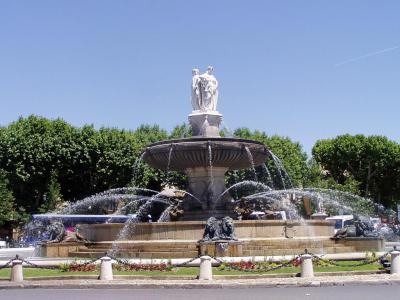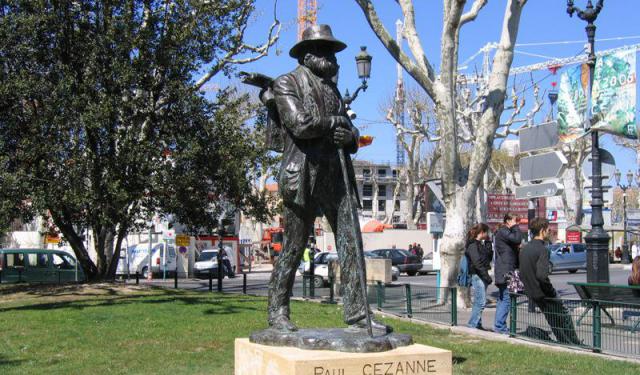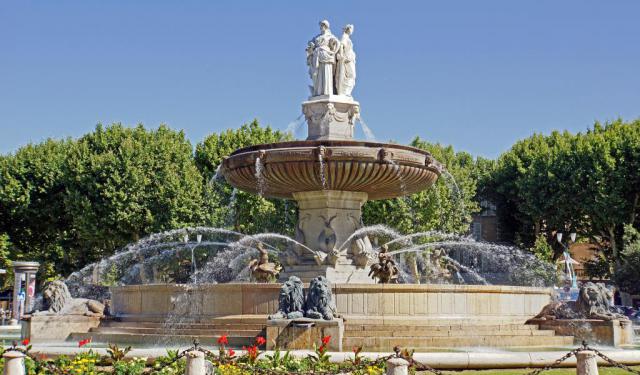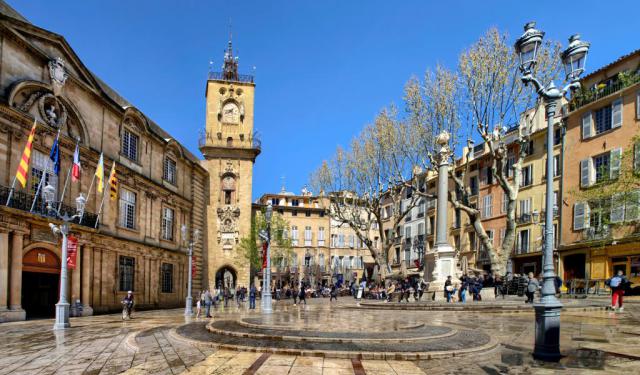Fontaine de la Rotonde (Fountain of the Rotunda), Aix-en-Provence
The Count of Valbelle checked out in 1779, but not before leaving the city of Aix a generous parting gift: 30,000 livres, which was the currency at the time. By November, the city decided to put that money to work-out went the crumbling ramparts, and in came plans for something more civic-minded. Ideas floated around for a while (as they tend to do), but it wasn’t until 1860 that the most iconic splash zone in town got born: the Fountain of the Rotunda.
Long known for its love affair with water-from Roman baths to bubbling neighborhood spouts-Aix needed a proper fountain to fortify its reputation. The Rotunda Fountain delivered. Towering nearly 40 feet, it was the first in the city to feature a cast-iron basin. Lions lounge around its edge like they own the place, while bronze children cling to swans mid-ride, adding just the right touch of misdemeanor.
Further up, a second bowl rests above the pool, this one guarded by snarling cheetah heads that look like they’ve seen things. Crowning the whole affair is a trio of ladies-each facing a different destiny. “Justice,” by Joseph Marius Ramus, stares down Mirabeau Boulevard toward the courthouse. “Commerce and Agriculture,” by Louis Chabaud, keep watch toward Marseille’s factories. And “Fine Arts,” by Hippolyte Ferrat, gazes toward Avignon. Together, they’re known as the Three Graces-a rather dignified nickname for a fountain that never stops showing off.
Long known for its love affair with water-from Roman baths to bubbling neighborhood spouts-Aix needed a proper fountain to fortify its reputation. The Rotunda Fountain delivered. Towering nearly 40 feet, it was the first in the city to feature a cast-iron basin. Lions lounge around its edge like they own the place, while bronze children cling to swans mid-ride, adding just the right touch of misdemeanor.
Further up, a second bowl rests above the pool, this one guarded by snarling cheetah heads that look like they’ve seen things. Crowning the whole affair is a trio of ladies-each facing a different destiny. “Justice,” by Joseph Marius Ramus, stares down Mirabeau Boulevard toward the courthouse. “Commerce and Agriculture,” by Louis Chabaud, keep watch toward Marseille’s factories. And “Fine Arts,” by Hippolyte Ferrat, gazes toward Avignon. Together, they’re known as the Three Graces-a rather dignified nickname for a fountain that never stops showing off.
Want to visit this sight? Check out these Self-Guided Walking Tours in Aix-en-Provence. Alternatively, you can download the mobile app "GPSmyCity: Walks in 1K+ Cities" from Apple App Store or Google Play Store. The app turns your mobile device to a personal tour guide and it works offline, so no data plan is needed when traveling abroad.
Fontaine de la Rotonde (Fountain of the Rotunda) on Map
Sight Name: Fontaine de la Rotonde (Fountain of the Rotunda)
Sight Location: Aix-en-Provence, France (See walking tours in Aix-en-Provence)
Sight Type: Attraction/Landmark
Guide(s) Containing This Sight:
Sight Location: Aix-en-Provence, France (See walking tours in Aix-en-Provence)
Sight Type: Attraction/Landmark
Guide(s) Containing This Sight:
Walking Tours in Aix-en-Provence, France
Create Your Own Walk in Aix-en-Provence
Creating your own self-guided walk in Aix-en-Provence is easy and fun. Choose the city attractions that you want to see and a walk route map will be created just for you. You can even set your hotel as the start point of the walk.
In the Footsteps of Paul Cézanne
Paul Cézanne, often called the “father of modern art” for bridging 19th-century post-impressionism and the birth of early modernism, caused a bit of a stir early in his career. While staying with Doctor Gachet in Auvers-sur-Oise, he painted his take on Manet’s Olympia-but with a twist. Instead of just a reclining nude, Cézanne inserted himself into the scene, back turned, like a shy... view more
Tour Duration: 2 Hour(s)
Travel Distance: 3.0 Km or 1.9 Miles
Tour Duration: 2 Hour(s)
Travel Distance: 3.0 Km or 1.9 Miles
Aix-en-Provence Fountains and Squares Tour
Aix-end-Provence is known for its fountains. With more than 1,000 fountains, a tourist could spend weeks walking around the city without glimpsing them all. The fountains began appearing under the Roman empire when the Romans discovered Aix's natural thermal water source. They referred to the area as Aquae Sextiae or the Waters of Sextius.
The fountains appear throughout the city and are... view more
Tour Duration: 1 Hour(s)
Travel Distance: 1.6 Km or 1 Miles
The fountains appear throughout the city and are... view more
Tour Duration: 1 Hour(s)
Travel Distance: 1.6 Km or 1 Miles
Aix-en-Provence Introduction Walking Tour
Aix-en-Provence may not have coastal views, but it compensates in style with its Roman bathwater and city logistics. Founded in 123 BC by Roman consul Gaius Sextius Calvinus, this southern French settlement-originally named Aquae Sextiae, which means “Waters of Sextius”-was built around its thermal springs and the promise of a good soak. Centuries later, the name was streamlined to “Aix”,... view more
Tour Duration: 1 Hour(s)
Travel Distance: 1.7 Km or 1.1 Miles
Tour Duration: 1 Hour(s)
Travel Distance: 1.7 Km or 1.1 Miles






